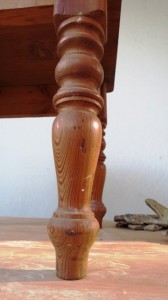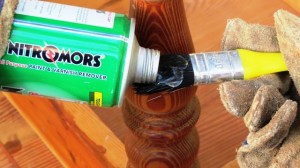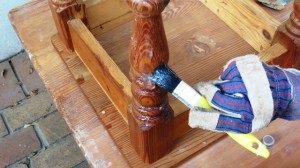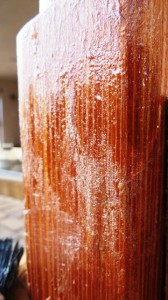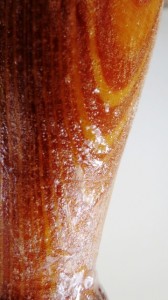I love wood. I specifically love naked wood. Wood that is as close to its natural state as possible. I would even go as far as calling myself a wood snob because I have no qualms about painting over wood that offends my perception of what good wood looks like. Our house is full of those horrible built-in chipboard cupboards and although they are very handy with loads of space, I can not stand the look of them. So one of these days I will paint them – not black – but very definitely some kind of colour so that they can stop pretending to be wood.
However today’s post is not about dem cupboards, today’s post is about two beautiful pine coffee tables that look horribly dated due to layers and layers of varnish. They are also bound for our new and updated TV room, so I would like to stain them a little darker as well, but that is a post for another day. For today it is all about getting rid of the varnish. I have no issues with sanding, as a matter of fact I love doing it. This is probably due to a combination of being an 80’s kid with a deep appreciation for Mr Miyagi’s ‘Wax on, wax off‘ lesson and the smell of the whole business. However these coffee tables have turned legs, which doesn’t lend itself to easy sanding and another plan had to be made.
I discovered the awesomeness of Nitromors while we were renovating the kitchen way back in 2009. Truly awful linoleum covered the floor and after getting the first layer off, I had to deal with gunky glue so stubbornly stuck that we burnt out a heat gun on it, to no avail. Someone then suggested we try Nitromors to strip the glue. It was a thing of beauty to see it in action, in a couple of hours I got more floor clean than during the whole of the two preceding days. Thus Nitromors and I became friends, best of friends as a matter of fact. So it was not without good reason that I turned to it again when faced with cleaning the turned table legs.
A quick word of caution on Nitromors – follow the safety instructions on the bottle!
This stuff is the Mohammed Ali of chemicals – it floats like a butterfly and stings like a bee. Well not totally, you are the one doing the floating like a butterfly if you don’t work in a well ventilated area (Nitromors and I became best friends in our pantry, with the door closed /0\, can you say headache?) but it does sting like a bee. So heed the instructions, wear gloves and safety goggles – yeah, you are going to feel like a bit of an idiot, but trust me on this, YOU DO NOT WANT THIS STUFF TO GET INTO YOUR EYES. Yes, that is meant to be shouty, it burns like hell!
So with safety rant over and done with, here is how you use this magical stuff for removing varnish and paint from wood.
- Apply a thick layer of Nitromors on a smallish area, using a paint brush. Use a dabbing action to apply it, do not brush it out. You don’t want to Nitromors to dry on the wood so keep the areas small enough to get it off before it dries.
- Let it stand for about five minutes until the paint/varnish starts blistering. Right about when you start thinking about misquoting Shakespeare, apply a second coat of Nitromors. Use your brush to work the Nitromors into the blistered paint and leave it for twenty minutes. Add more Nitromors on patches that dry out during this period.
- Remove the blistered or softened paint with a paint scraper. This is the really rewarding part, so enjoy it!
- Once you are done, scrape that gunk onto newspaper and let it dry. It is still has bite when it is wet, so please don’t try and scrape it together with your bare hands into a plastic bag. By the time you come back from washing your hands, the plastic bag will be in tatters (who says you can’t learn from a fool?). Use warm soapy water and a dishwashing sponge to wipe off the last bits of Nitromors.
I didn’t get all the varnish off the first time around, mostly due to bad light and not having the right tools available. The manufacturer suggests using course wire wool for the more intricate parts, so I will procure some of that and try it on the rest of the legs. Next time I am trying my hand at wood staining. I have bought a really dark, oaky (according to the bottle, in any case) one, so I am excited to see how that turns out.
Until then, wax on, wax off and remember to breathe.


